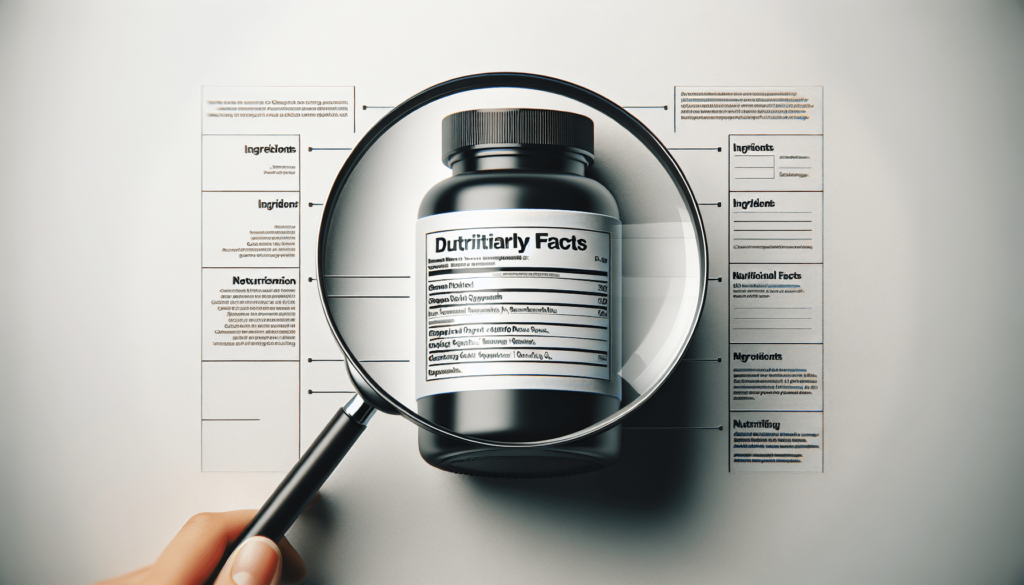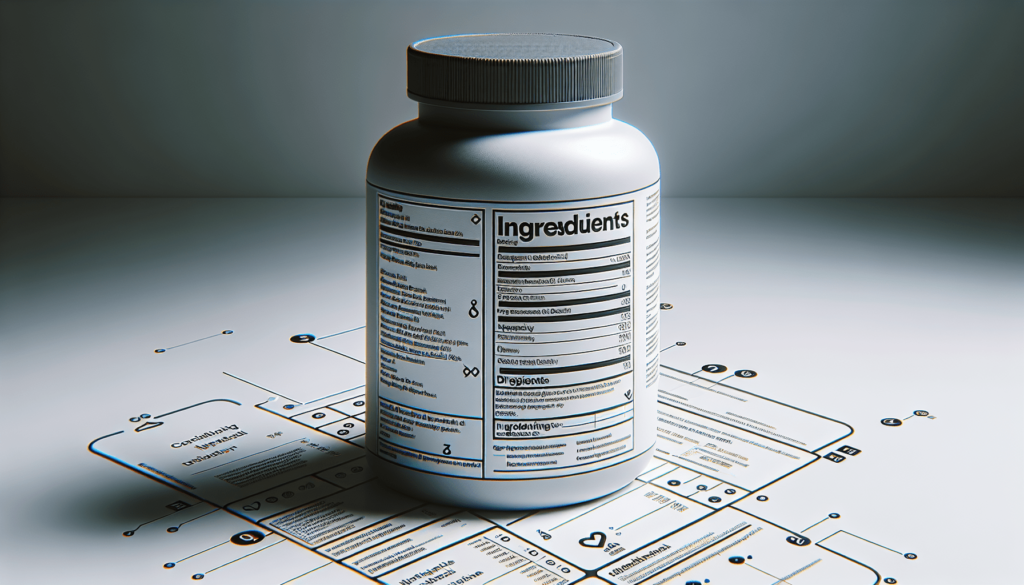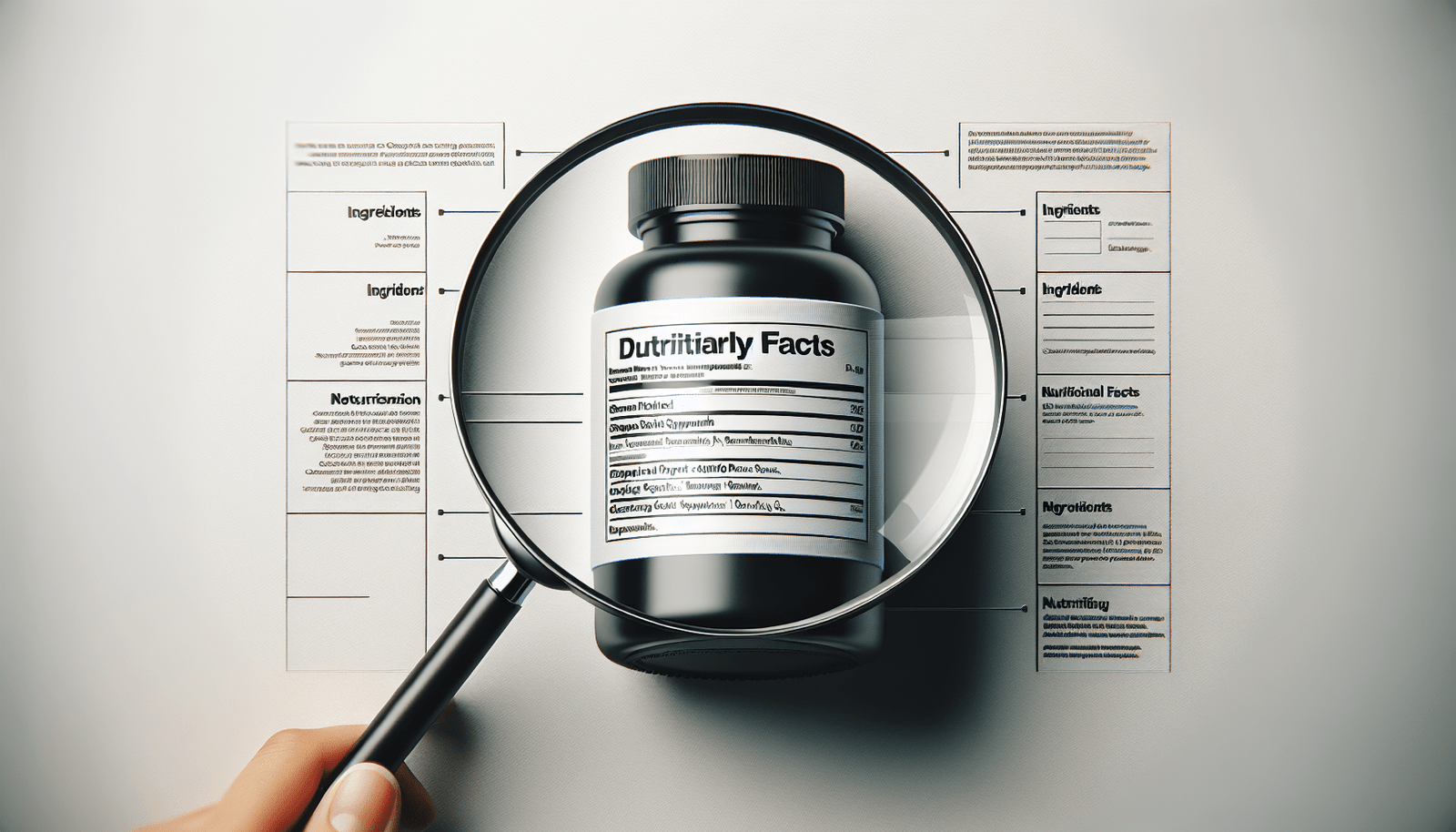Are you confused when it comes to reading the labels on nutraceutical products? Don’t worry, you’re not alone. With so many different ingredients and claims, deciphering the information can be a daunting task. In this article, we’ll guide you through the process of understanding nutraceutical labels, helping you make informed choices about the products you choose to consume. Get ready to decode the mysteries behind these labels and take control of your health.

Understanding the Nutraceutical Label
Nutraceutical definition
When it comes to understanding nutraceutical labels, it’s important to first understand what exactly a nutraceutical is. The term “nutraceutical” is a combination of the words “nutrition” and “pharmaceutical.” It refers to a product that is derived from food sources and offers potential health benefits beyond basic nutrition. Nutraceuticals can include dietary supplements, functional foods, and drinks, as well as other products that contain bioactive compounds. These products are designed to promote wellness, prevent diseases, and enhance overall health.
Important information on the label
Nutraceutical labels provide a wealth of information that can help you make informed decisions about the products you consume. They are regulated by organizations such as the Food and Drug Administration (FDA) and must adhere to certain guidelines. It’s important to pay attention to key components of the label, including serving size, amount per serving, daily value, list of ingredients, warnings and precautions, storage instructions, and manufacturing and expiration dates. By understanding these components, you can better evaluate the nutraceutical product and its potential impact on your health.
Key Components of Nutraceutical Labels
Serving size
One of the first things you’ll notice on a nutraceutical label is the serving size. This information indicates a recommended portion size of the product. It’s important to remember that the serving size may not always be the same as the portion you normally consume. The purpose of providing a serving size is to allow consumers to accurately measure and track their intake of nutrients and other components.
Amount per serving
The amount per serving section of the label provides detailed information about the quantity of various nutrients and components in each serving. This includes information such as the number of calories, macronutrients like carbohydrates, protein, and fat, as well as micronutrients like vitamins and minerals. This information allows you to understand the nutritional content of the product and make informed choices about its consumption.
Daily value
The daily value section provides information on the percentage of each nutrient in a serving compared to the daily recommended intake. These recommendations are based on a 2,000-calorie diet and are intended as general guidelines. This information helps you understand how the product fits into your overall daily nutrient needs.
List of ingredients
The list of ingredients is an essential component of a nutraceutical label. It provides a comprehensive list of all the substances used in the product, starting with the most abundant ingredient and descending in order. This list allows you to identify potential allergens, intolerances, or substances you may want to avoid. In addition, it can help you evaluate the quality of the product and determine if it contains any additives, fillers, or unnecessary ingredients.
Warnings and precautions
Many nutraceutical labels include warnings and precautions that are important to consider. This section alerts consumers to potential risks, interactions, or side effects associated with the product. It’s crucial to read and understand these warnings, especially if you have any existing health conditions, allergies, or are taking medications. By following the guidance provided in this section, you can ensure the safe and effective use of the product.
Storage instructions
Proper storage is essential to maintain the quality, potency, and safety of nutraceutical products. The storage instructions section of the label provides guidance on how to store the product properly. This may include recommendations on temperature, humidity, light exposure, and potential hazards to avoid. Adhering to these instructions will help prolong the shelf life of the product and ensure its effectiveness.
Manufacturing and expiration dates
The manufacturing and expiration dates provide important information about the freshness and safety of the product. The manufacturing date indicates when the product was made, while the expiration date indicates when it is no longer guaranteed to be effective or safe to use. It’s important to carefully check these dates and consume the product within the recommended timeframe. Using expired or improperly stored products may lead to reduced efficacy or even potential health risks.
Decoding the Serving Size
What is serving size?
The serving size on a nutraceutical label refers to the recommended amount of the product to consume at one time. It is typically expressed in familiar measurements such as cups, ounces, or pieces. The serving size provides a standardized unit of measurement to help you accurately gauge your intake.
Importance of serving size
Understanding the serving size is crucial for managing your nutrient intake. By following the recommended serving size, you can accurately track your consumption of calories, macronutrients, and micronutrients. This is especially important if you have specific dietary goals or restrictions.
Different units of measurement
Serving sizes can vary depending on the type of product and its intended use. For example, a serving size for a protein powder may be measured in scoops, while a serving size for a juice may be listed as a specific volume in milliliters or fluid ounces. Paying attention to the unit of measurement will help you accurately portion out and compare serving sizes.
Comparing serving sizes
When comparing nutraceutical products, it’s important to note that serving sizes may differ. This can make it challenging to compare the nutritional content of different products. To make fair comparisons, it’s helpful to calculate the nutrient values based on the same serving size. This will allow you to see how the products stack up against each other in terms of their nutritional profiles.

Understanding Amount per Serving
Nutrient quantities per serving
The amount per serving section provides detailed information on the quantity of specific nutrients present in the product. This includes macronutrients such as carbohydrates, protein, and fat, as well as micronutrients like vitamins and minerals. By reviewing this section, you can determine the nutritional composition of the product and make informed decisions about its suitability for your dietary needs.
Percent daily value
The percent daily value (%DV) indicates the proportion of a specific nutrient in one serving relative to the recommended daily intake. The %DV is based on a 2,000-calorie diet and serves as a reference point for comparing different products. Higher %DV values indicate that a nutrient is present in a higher concentration relative to the recommended daily intake. This information can help you understand if a product is a good source of a particular nutrient.
Comparison with recommended intake
A key aspect of the amount per serving section is comparing the nutrient quantities with the recommended intake for a healthy diet. For example, if the %DV for protein is significantly higher than 100%, it indicates that the product provides a considerable portion of the recommended protein intake. On the other hand, if the %DV for nutrients like sodium or added sugars is higher than 100%, it’s important to consider moderation or alternative options.
Daily Value and Its Significance
Definition of daily value
The daily value is a reference value that represents the recommended intake of a specific nutrient for an average adult consuming a 2,000-calorie diet. It provides a benchmark for evaluating the nutritional content of a product and helps consumers make informed decisions about their dietary choices.
Determining nutritional adequacy
By comparing the daily value percentages on a nutraceutical label, you can assess the overall nutritional adequacy of the product. Adequate intake of nutrients is essential for maintaining good health, and the daily value can help you identify products that can contribute to a well-rounded diet.
Utilizing the daily value percentages
While the daily value percentages are based on a 2,000-calorie diet, individual calorie needs may vary. To tailor the recommendations to your specific needs, you can adjust the %DV accordingly. If you require more or fewer calories than the average, you can calculate the precise values by scaling up or down. This allows you to personalize your nutrient intake based on your unique circumstances.
Deciphering the List of Ingredients
Ingredients in descending order
The list of ingredients on a nutraceutical label is required to be in descending order by weight. This means that the ingredient present in the greatest amount will be listed first, followed by those in decreasing quantities. By reviewing this list, you can better understand the overall composition of the product.
Identifying potential allergens
The list of ingredients is crucial for individuals with allergies or intolerances. By carefully examining the ingredients, you can identify potential allergens that you need to avoid. Common allergens, such as peanuts, soy, dairy, and gluten, should be clearly labeled to help you make informed decisions about the suitability of the product for your dietary needs.
Recognizing additives and fillers
The list of ingredients can also provide insight into the quality of the product. Ingredients that are less familiar or have chemical-sounding names may indicate the presence of additives, fillers, or preservatives. While some additives are harmless, others may have unwanted side effects or be of concern to certain individuals. Being aware of these ingredients allows you to make informed decisions and choose products that align with your preferences and requirements.
Warnings and Precautions
Safety concerns
Nutraceutical products may carry warnings and precautions related to their safe use. This section typically alerts consumers to potential risks, side effects, or interactions with other medications or health conditions. It is crucial to read and understand these warnings to ensure the proper and safe use of the product. If you have any concerns or questions, it’s always a good idea to consult with a healthcare professional.
Special population considerations
Certain nutraceutical products may have specific warnings or precautions for certain populations, such as pregnant or nursing women, children, or individuals with specific medical conditions. It’s important to pay attention to these considerations to ensure the product is suitable for your individual circumstances. If you fall into one of these special population groups, consulting with a healthcare professional can help you make an informed decision about the product’s use.
Storage Instructions
Optimal storage conditions
Proper storage is crucial to maintaining the quality, potency, and safety of nutraceutical products. The storage instructions section on the label provides guidance on how to store the product correctly. This may include recommendations on temperature, humidity, light exposure, and potential hazards to avoid. Following these instructions will help preserve the product’s integrity and ensure its effectiveness.
Avoiding contamination
The storage instructions can also help prevent contamination. Nutraceutical products, like any other consumable items, can be susceptible to bacteria, mold, or other contaminants if not stored properly. By adhering to the recommended storage conditions, you can minimize the risk of contamination and ensure the safety of the product.
Handling temperature-sensitive products
Some nutraceutical products may be sensitive to temperature fluctuations. Extreme temperatures, such as excessive heat or cold, can degrade the product’s quality and efficacy. The storage instructions will provide guidance on the appropriate temperature range to maintain. This will help preserve the integrity of the product and ensure its effectiveness when consumed.
Determining Manufacturing and Expiration Dates
Batch number and manufacturing date
The manufacturing information on the label can provide insight into the product’s quality and freshness. It typically includes the batch number and the manufacturing date. The batch number allows for traceability and quality control purposes, while the manufacturing date indicates when the product was produced. This information is important to consider when evaluating the freshness and effectiveness of the product.
Shelf life and expiration date
The shelf life and expiration date are key pieces of information on a nutraceutical label. The shelf life refers to the period during which the product is expected to remain stable, safe, and retain its desired quality. The expiration date indicates the last date on which the product is guaranteed to remain effective and safe to use. It’s important to consume the product before the expiration date to ensure maximum potency and safety. Using expired products may lead to reduced efficacy or potential health risks.
Importance of freshness
Freshness is crucial when it comes to nutraceutical products, as their potency and effectiveness may diminish over time. By paying attention to the manufacturing and expiration dates, as well as the storage instructions, you can ensure that you are consuming a fresh and effective product.
Looking for Additional Certifications
Third-party testing and certifications
Some nutraceutical products may carry additional certifications or labels from third-party organizations. These certifications indicate that the product has undergone independent testing and meets specific quality or safety standards. Examples of such certifications include Good Manufacturing Practice (GMP) and USP Verified labels. These certifications provide additional assurance of the product’s quality, purity, and potency.
Quality assurance measures
In addition to third-party certifications, nutraceutical companies may also implement their own internal quality assurance measures. These measures may include rigorous testing, quality control procedures, and adherence to specific manufacturing standards. Paying attention to any quality assurance claims made by the company can provide further confidence in the product’s safety and effectiveness.
Organic, non-GMO, and other labels
Some consumers may have specific preferences when it comes to choosing nutraceutical products. Labels such as “organic” or “non-GMO” indicate specific attributes of the product, such as the absence of genetically modified organisms or the use of organic ingredients. These labels can help you align your purchase with your personal values or dietary preferences.
In conclusion, understanding the nutraceutical label is essential for making informed decisions about the products you consume. By paying attention to the serving size, amount per serving, daily value, list of ingredients, warnings and precautions, storage instructions, and manufacturing and expiration dates, you can evaluate the product’s nutritional content, safety considerations, and overall quality. Remember to use this information as a guide to support your health goals and consult with a healthcare professional if you have any specific concerns or questions. With a thorough understanding of nutraceutical labels, you can confidently choose products that contribute to your overall well-being.
